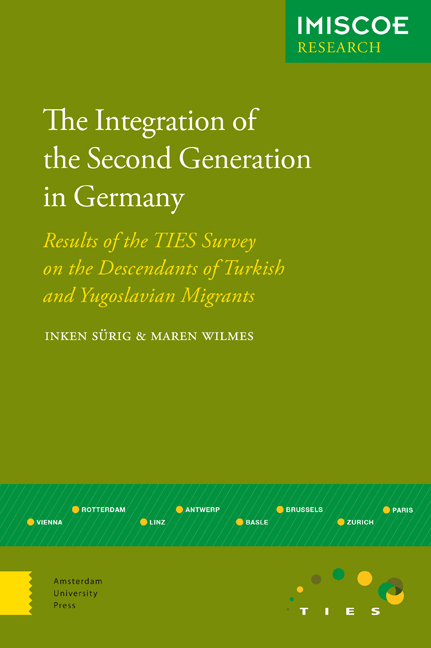 The Integration of the Second Generation in Germany
The Integration of the Second Generation in Germany Book contents
- Frontmatter
- Contents
- Preface: The International Research Project TIES
- 1 Introduction
- 2 Migration History and Basic Demographic Characteristics of the First Generation
- 3 Educational Careers and Educational Outcomes
- 4 Labour Market Positions
- 5 Segregation and Housing
- 6 Ethnic and Cultural Orientations
- 7 Social Relations
- 8 Family Formation and Partner Relationships
- 9 Conclusions and International Comparisons
- References
- Other IMISCOE Research Titles
5 - Segregation and Housing
Published online by Cambridge University Press: 11 December 2020
- Frontmatter
- Contents
- Preface: The International Research Project TIES
- 1 Introduction
- 2 Migration History and Basic Demographic Characteristics of the First Generation
- 3 Educational Careers and Educational Outcomes
- 4 Labour Market Positions
- 5 Segregation and Housing
- 6 Ethnic and Cultural Orientations
- 7 Social Relations
- 8 Family Formation and Partner Relationships
- 9 Conclusions and International Comparisons
- References
- Other IMISCOE Research Titles
Summary
Introduction
Residential segregation describes the degree of urban social dissimilarity as it is reproduced in the physical city space. This is based on the assumption that residential dissimilarity is not random, but the result of the allocation of social groups to specific segments of the housing market along the lines of social disparities (Dangschat 1998). The main factors influencing a population's distribution within a city's space are income (often dependent on educational levels, as discussed in the previous chapters) and the actual differentiation of the housing market. This is particularly evident in the proportion of social housing projects in different areas, leading to an unequal spatial distribution of accommodation options. Since migrant groups in Germany often have lower levels of education and income than the majority population (see also the preceding chapters), they are disproportionately represented in underprivileged neighbourhoods. Affiliations with people from the same country of origin can also become important as a factor shaping segregation. This occurs when a neighbourhood's concentration of one group of the same national origin grows dense enough to facilitate considerable ‘ethnic entrepreneurship’ and organisation-building. As a result, residents’ day-to-day interactions are largely limited to members of their own group of origin, thus restricting social mobility and increasing the likelihood that social inequality will be reproduced (Friedrichs & Triemer 2009). However, this does not apply to German cities to the same extent as it does to other parts of Europe or North America. In Germany, even neighbourhoods with high ratios of migrants display a ‘multinational’ composition, and it is rare for a single group to constitute more than half of the population of an urban district (Häusermann & Kapphahn 2008). In terms of segregation indices, then, most of Germany's big cities remain on a low to moderate level regarding both social and ethnic segregation. In cities with greater dissimilarities, ethnic segregation indices systematically exceed those of social segregation, and in cities with lower dissimilarity indices the opposite applies (Friedrichs & Triemer 2009). Table 5.1 displays Germany's three most and three least segregated big cities.
- Type
- Chapter
- Information
- The Integration of the Second Generation in GermanyResults of the TIES Survey on the Descendants of Turkish and Yugoslavian Migrants, pp. 101 - 132Publisher: Amsterdam University PressPrint publication year: 2015


